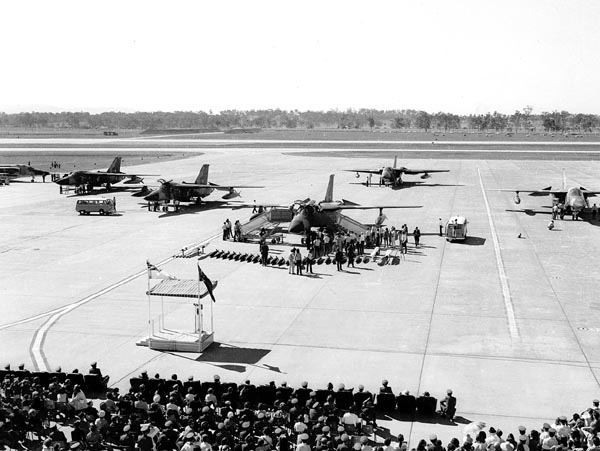Archived Aardvark

Remembering the F-111
It’s just over four year ago since the last F-111 landed at RAAF Amberley holding the (sad) record of the last ever F-111 to fly. It closed a long, distinguished and controversial chapter in the history of our nation’s air power.
Australia’s involvement with the F-111 began over 40 years ago, with the Menzies Government ordering 24 of the new General Dynamics F-111. This swing-wing fighter-bomber was the winner of a joint USAF-USN program to find a next gen aircraft. From the commencement of the Tactical Fighter Experiment (TFX) program, the project was besieged by technical difficulties, cost overruns and delayed timelines. Australian taxpayers and the Labor opposition at the time pounded the government for their perceived lack of due diligence in the purchase of this untested aircraft.

Interestingly, the delay of the F-111, and the inability to maintain Australia’s tactical air power with its ageing fleet of Meteors and Canberras resulted in a short term loan of McDonnell Douglas F-4E Phantom IIs from the USAF. These aircraft were much loved by the air and ground crew who flew & worked on them. Their advanced nature compared to the English Electric Canberra allowed the RAAF to experience a technically advanced aircraft. This experience prior to the introduction of the F-111 is sometimes credited with the resulting Australian success with the ‘Pig’. They performed with distinction in Australian service with only one aircraft lost during the service period.
The first F-111 to landed on Australian soil on 1 June 1973. Received with the standard pomp and fanfare, it propelled Australia into the next generation of air warfare capability. By the end of 1973, Australia had a fleet of 20 F-111s in service. Through the F-111’s service period, additional aircraft were sourced including four ex-USAF F-111As in 1982, which were subsequently upgraded to a C standard. During 1980, four of the original F-111Cs were converted to reconnaissance RF-111s reconnaissance models with cameras replacing internal bomb payloads.
To assist the management of aircraft attrition, an additional four ex-USAF F-111As were obtained in 1983 and modified to RAAF F-111C standards. In the early 1990s, fifteen G models were obtained from the USAF. The G variant was both structurally and technologically more advanced with modified intake design, more powerful turbofans and an upgraded avionics suite. One airframe was the ‘Boneyard Wrangler’ A8-272, which was the only F-111 to be flown out of AMARC.

Although the F-111s never saw combat service with the RAAF, the did provide valuable intel in the initial days of the East Timor Independence conflict, which helped to cement Australia’s global role as a military leader. They were even used to spy on Tasmania! The aircraft was also much loved by the Australian public, featuring at air shows and displays around the country. It was the closing highlight of Brisbane’s Riverfire spectacular until 2009.
With the delays in development and production of the F-35 Lightning II (Joint Strike Fighter), the RAAF identified a capability gap between the Lightning’s introduction, and the retirement of the F-111. Twenty four F/A-18F Super Hornets have been acquired and the fleet achieved final operational capability in December 2011.


The F-111’s end came on the 15th of October 2010 at Amberley; the place it had begun four decades ago. Six aircraft took flight and flew from Amberley, over Brisbane and Ipswich cities, accompanied by two of the new Super Hornets and a Hawk camera ship. Each aircraft performed a number of passes, missed approaches and of course, the final dump & burn, before landing and taxiing to the apron for the final time.
The fleet, already reduced by attrition and planned non-maintenance was stored at Amberley whilst the airframe fates were decided. On 21st April 2012, the Defence Minister Jason Clare announced that seven aircraft would be ‘peremenantly loaned’ to museums, and another two becoming gate guards at RAAF bases. Due to draconian United States Military export laws, the remiander of the fleet were partially destroyed and buried unceremoniously in landfill at Swanbank, close to their former home at RAAF Amberley.
The retirement of the F-111 brought to an end a number of eras including Australia’s only swing wing aircraft and the sole dump & burn capability in the world. The ‘pig’ is undoubtably etched in the minds of the Australia public through its long and impressive service life. The F-111 lives on through a strong heritage around Australia at the following museums and RAAF bases.
- Aviation Historical Society of the Northern Territory
- Evans Head Memorial Aerodrome Heritage Aviation Association
- Fighter World, Williamtown
- Historical Aircraft Restoration Society
- Queensland Air Museum
- South Australian Aviation Museum
- RAAF Amberley Aviation Heritage Centre
- RAAF Museum, RAAF Base Point Cook
- RAAF Base Edinburgh
- RAAF Base Wagga

Further reading
‘F-111 Down Under‘ – F-111.net
‘F-111 External Differences‘ – F-111.net
‘Forty years of the Pig‘ – Andrew Stackpool
‘General Dynamics RF-111C‘ – Spyflight.uk
‘RF-111C‘ – Global Security
‘RAAF A8 F-111 C/G & RF-111C‘ – ADF-Serials.com.au
‘Why Australia should retain its F-111 fleet‘ – Dr Carlo Kopp, ausairpower.net
‘Preferred F-111 recipients‘ – Minister for Defence Media Releases
Author
Tim Dwyer – @timdwyer

